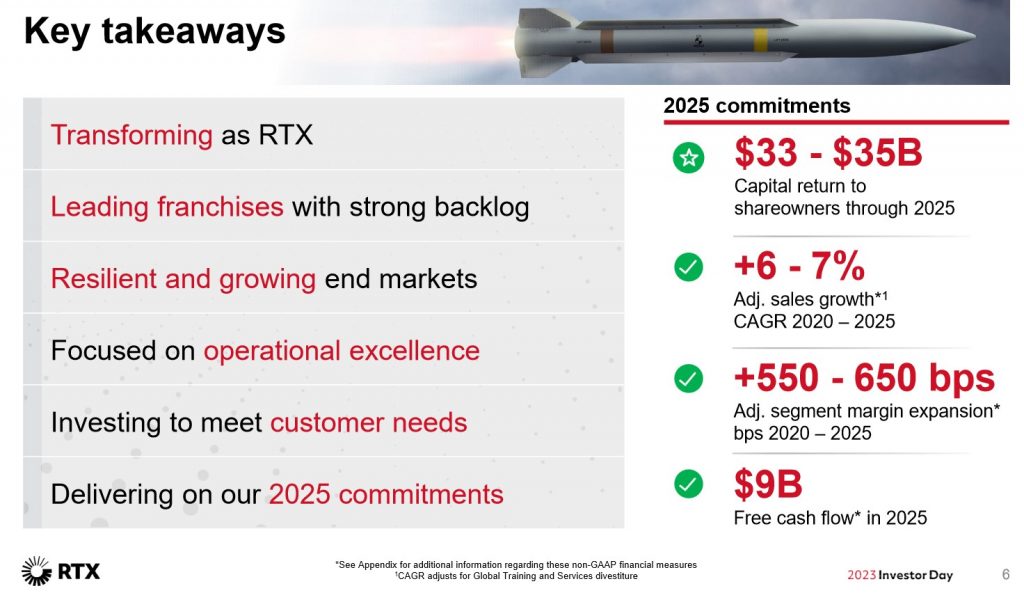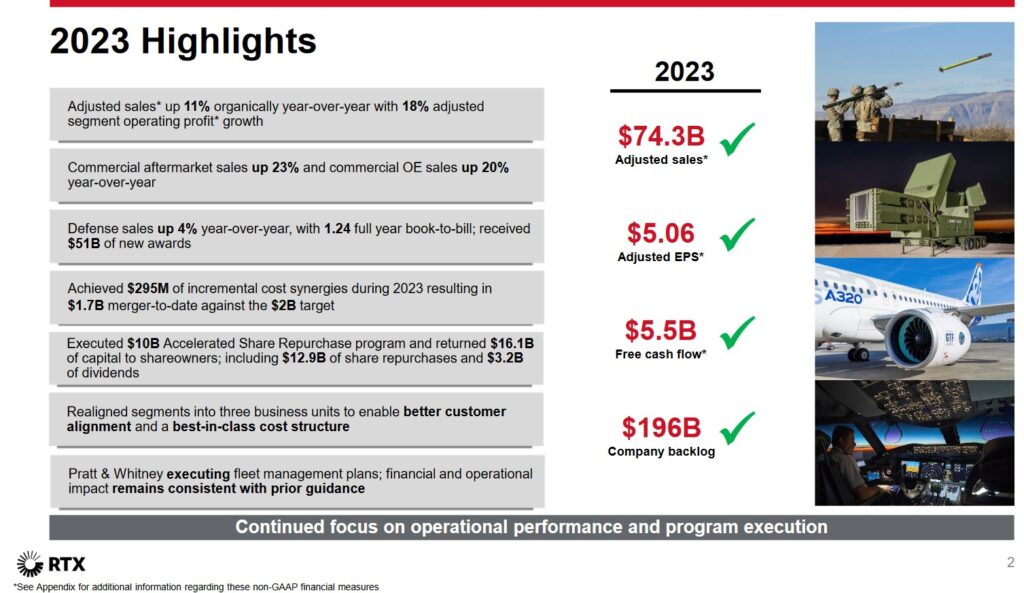Contents
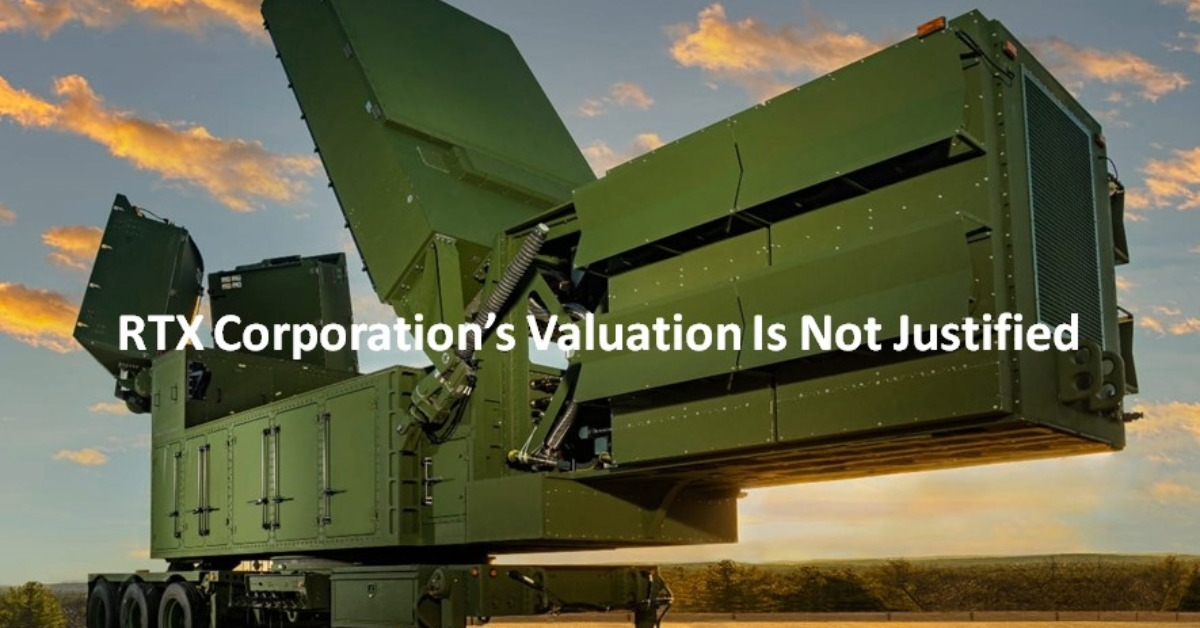
I last reviewed RTX Corporation (RTX) in this October 29, 2023 post at which time it had just released its Q3 and YTD 2023 results. After reviewing the Q4 and FY2023 results and FY2024 outlook, I conclude RTX Corporation's valuation is not justified.
When I completed my 2023 Year End FFJ Portfolio Review, RTX was not a top 30 holding. Unless its valuation improves, RTX is unlikely to crack the top 30 any time soon.
Business Overview
Investors unfamiliar with RTX should review the company's website and Part 1 Item 1 within the 2022 Form 10-K. Additional information is also found on page 9 of 182 in the Q3 2023 Form 10-Q.
Another key document to review is RTX's 2023 Proxy Statement. The 2024 Proxy Statement is likely to be available in mid-March.
2023 Investor Day
In my July 29 post, I provided a link to the details RTX presented at its June 19, 2023 Investor Day. I provide them again for ease of reference with the following being the key takeaways.
Financials
Q4 and FY2023 Results
RTX has yet to release its FY2023 Form 10-K as I compose this post. However, I provide links to RTX's Earnings Release, and Earnings Presentation released on January 23.
When reviewing RTX's FY2023 results, it is important to remember that on July 25, RTX Corporation (RTX) surprised the investment community when it disclosed that its Pratt & Whitney (P&W) operating segment identified microscopic contaminants in a metal used in part of the Geared Turbofan (GTF) engines that power Airbus' popular A320neo jets.
On September 11, RTX held a Pratt & Whitney GTF Fleet Update Conference Call to update the investment community.
The demand for RTX's products and services in both commercial aerospace and defense remains strong. Air travel has surpassed pre-pandemic levels, and the global threat environment is driving unprecedented demand, especially in air defense systems.
RTX remains focused on ensuring that business continues to be positioned to achieve sustained growth. In FY2023, it spent almost $10B in CAPEX in company and customer-funded R&D.
It captured ~$95B in new bookings, resulting in company-wide backlog growth of 12% and a book-to-bill of 1.28, ending the year with a record RTX backlog of $196B.
Challenges
Looking at page 17 in RTX's Form 8-K, we see that the P&W operating segment had a very challenging FY2023.
For the twelve months ended December 31, 2023, RTX incurred a net pre-tax charge of $2.9B related to the Pratt powder metal matter during Q3. The charge is reflected in the Condensed Consolidated Statement of Operations as a reduction of sales of $5.4B which was partially offset by a net reduction of cost of sales of $2.5B primarily representing RTX's partners’ 49% share of this charge. The charge includes RTX's current best estimate of expected customer compensation for the estimated duration of the disruption as well as the Q3 Estimate-at-Completion (EAC) adjustment impact of this matter to Pratt & Whitney’s long-term maintenance contracts. Management has determined that these items are directly attributable to the powder metal matter, incremental to similar costs (or income) incurred for reasons other than those related to the powder metal matter and not expected to recur, and therefore, not indicative of the Company’s ongoing operational performance.
RTX continues to experience profitability challenges driven by productivity headwinds, primarily attributable to legacy fixed-price development programs as well as continued supply chain and operational headwinds.
Productivity improvements, however, are being achieved in several parts of RTX's business. For example, RTX is using its Customer Oriented Results and Excellence (CORE) next generation operating system to refine work instructions, increased test equipment uptime and reduce product cycle time, all without additional capital or manpower.
It has also recognized productivity gains by successfully retiring technical and schedule risks on contracts.
These gains, however, have been overcome from challenges on fixed price development programs and unfavorable material costs as well as supplier delinquencies.
In order to address these challenges, RTX is:
- improving its fixed price development programs as it satisfies certain technical and programmatic milestones;
- being more selective and disciplined about the work it pursues;
- modifying its approach to winning new work. This entails ensuring new contracts and additional contractual lots have better protection from supplier inflation.
- continuing to drive improved supply chain performance and material flow.
- taking indirect cost actions to avoid some of the headwinds experienced in 2022 and 2023. RTX, for instance, recently further consolidated and streamlined several of sub-business units to reduce indirect costs and overhead.
RTX expects a lingering effect of the past couple of years' inflation as it delivers on its backlog. In FY2024, RTX expects to see ~$1.7B of material and labor inflation. This, however, is expected to be more than offset by higher pricing and the benefits from digital transformation projects and other aggressive cost reduction initiatives.
FY2024 Outlook
RTX's FY2024 is reflected below. A couple of key assumptions are embedded in the outlook as it relates to the 2 dispositions announced last year which I touched upon in my October 29 post.
- the sale of RTX's cybersecurity business will close in Q1 thus resulting in a ~$1.3B YoY reduction in reported sales and a ~$80 million YoY headwind to operating profit; and
- the Collins' segment outlook includes the actuation business as RTX continues to work on the business disposition.
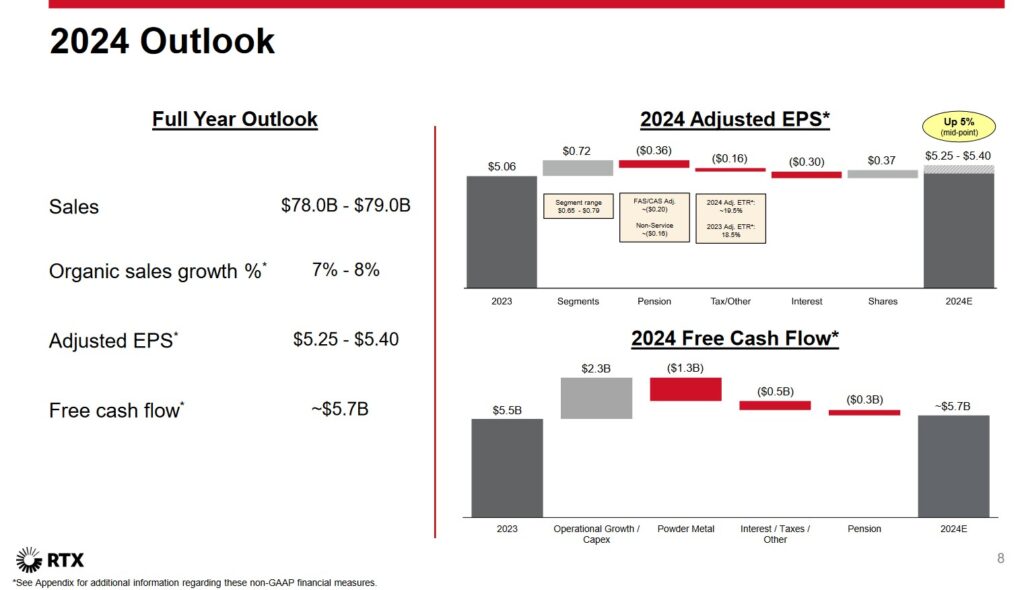
Source: RTX - Q4 2023 Earnings Presentation
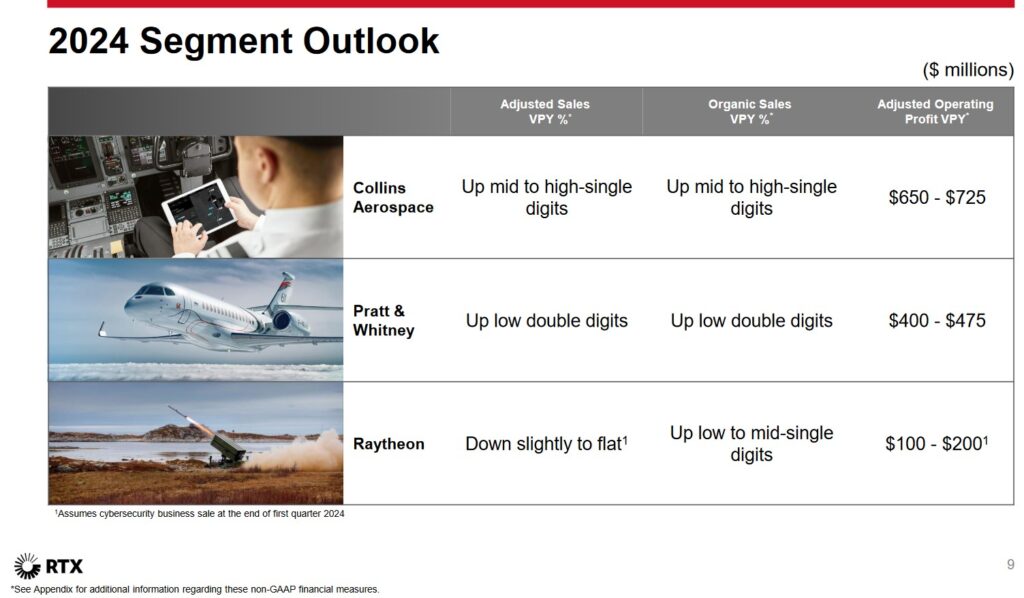
Source: RTX - Q4 2023 Earnings Presentation
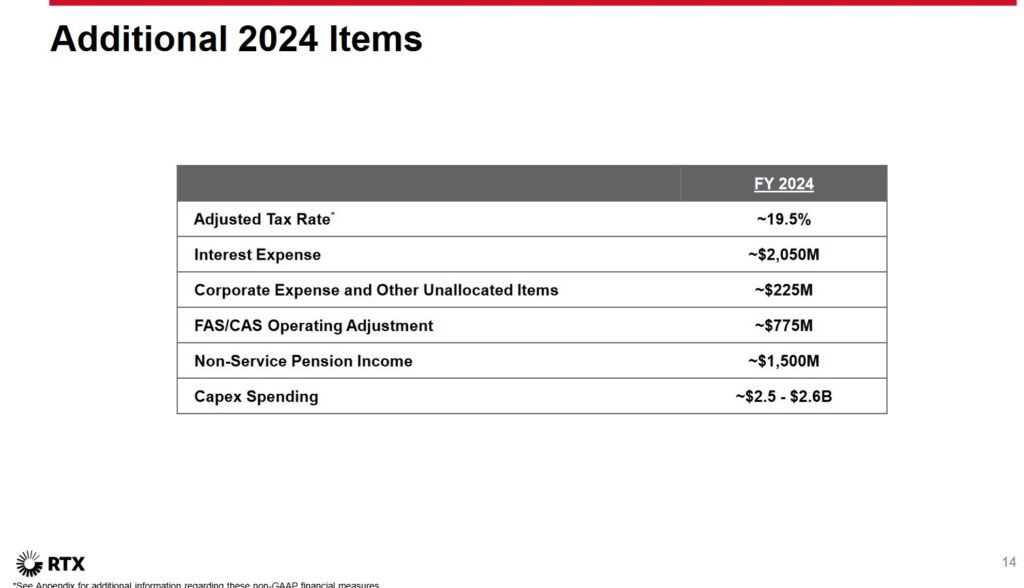
Source: RTX - Q4 2023 Earnings Presentation
Credit Ratings
In FY2023, RTX received just over $12.9B in proceeds from long-term debt; it repaid just under $0.6B. The proceeds were used to retire the $10B borrowed to effect the $10B accelerated share repurchase program (ASR) I addressed in my October 29 post.
On the Q4 earnings call, management stated that it is beginning the process of deleveraging to ensure RTX maintains a strong balance sheet. This deleveraging will be in part supported by the closure of previously announced divestitures (addressed in my October 29 post).
Until such time as RTX deleverages, Moody's currently assigns a Baa1 rating to RTX's senior unsecured domestic currency debt with a negative outlook.
S&P Global also lowered its A- rating to BBB+ for RTX Corp.'s senior unsecured notes. This rating is equivalent to that assigned by Moody's.
Both ratings are the top tier of the lower medium-grade category and define RTX as having an ADEQUATE capacity to meet its financial commitments. However, adverse economic conditions or changing circumstances are more likely to lead to a weakened capacity to meet its financial commitments.
Both ratings are investment grade and are acceptable for my purposes.
Dividend and Dividend Yield
When I wrote my July 29 post, I disclosed the purchase of an additional 100 shares at $85.67. Using this purchase price and the $0.59 quarterly dividend (see dividend history), the dividend yield was ~2.75%.
Following the September 11 Press Release, I acquired an additional 100 shares @ $78/share. Based on RTX's historical dividend increases, I envisioned the declaration of an increase from $0.59 to $0.63 in April.
RTX's share price has subsequently appreciated to $89.55 at the January 23, 2024 market close. I project the next 4 quarterly dividend payments will total $2.48 ((1 x $0.59) + (3 x $0.63)) thus resulting in a ~2.77% forward dividend yield.
RTX's weighted average number of issued and outstanding shares in FY2010 - FY2023 (in millions rounded) is 923, 907, 907, 915, 912, 883, 826, 799, 810, 864, 1,358, 1,509, 1,486, and 1,435.In Q4, however, RTX repurchased $10.283B of its shares by way of an accelerated share repurchase program which I addressed in my October 29 post. This reduced the weighted average number of shares outstanding in Q4 2023 to 1,361.7.
Valuation
When I wrote my September 12 post, RTX had not amended its FY2023 adjusted diluted EPS guidance of $4.95 - $5.05. Using my recent $78 purchase price and the $5 mid-point of management's guidance, the forward adjusted diluted PE was ~15.6.
The valuation using broker estimates and my $78 purchase price was:
- FY2023: 19 brokers, mean estimate $5.01, low/high range $4.95 – $5.05. The valuation using the mean estimate was ~15.6.
- FY2024: 21 brokers, mean estimate $5.57, low/high range $4.70 – $5.87. The valuation using the mean estimate was ~14.
- FY2025: 16 brokers, mean estimate $6.65, low/high range $6.25 – $7.20. The valuation using the mean estimate was ~11.7.
With the release of Q3 results on October 24, RTX amended its FY2023 adjusted diluted EPS to $4.98 - $5.02 from $4.95 - $5.05. With shares having closed at ~$79.15 on October 27, the forward adjusted diluted PE was ~15.85.
The valuation using broker estimates and ~$79.15 was:
- FY2023: 23 brokers, mean estimate $5.01, low/high range $4.93 – $5.05. The valuation using the mean estimate was ~15.8.
- FY2024: 24 brokers, mean estimate $5.49, low/high range $4.70 – $5.90. The valuation using the mean estimate was ~14.4.
- FY2025: 19 brokers, mean estimate $6.47, low/high range $5.92 – $6.95. The valuation using the mean estimate was ~12.2.
I considered ~$105 - ~$110/share to be a fair value based on current forward-adjusted diluted EPS estimates.
In my October 29 post, I also indicated one of RTX's 2025 commitments presented at its June 19, 2023 Investor Day was to generate $9B in FCF. With the $10B ASR and further share repurchases in FY2024 and FY2025, I indicated it was realistic to expect RTX's weighted average diluted shares outstanding to fall to ~1.3B. As noted earlier, the weighted average number of shares outstanding in Q4 2023 to 1,361.7 so my ~1.3B estimate is achievable.
We now know that RTX generated diluted EPS of $2.23 and adjusted diluted EPS of $5.06 in FY2023. With shares trading at $89.55, the diluted PE is ~40.2 and the adjusted diluted PE is ~17.7. RTX's PE based on GAAP earnings are distorted because of the significant P&W powder metal charges. Investors should, therefore, look at RTX's valuation based on adjusted earnings.
In FY2023, RTX generated $5.468B of FCF and the weighted average number of shares outstanding in Q4 2023 was 1,361.7 (millions of shares) giving us FCF/share of ~$4.02. The share price at the time of my prior post was ~$79.15 for a P/FCF of ~19.7. Using the current ~$89.55 share price, the P/FCF is ~22.3.
The valuation using broker forward adjusted diluted EPS estimates and ~$89.55 is:
- FY2024: 23 brokers, mean estimate $5.29, low/high range $4.55 – $5.59. The valuation using the mean estimate is ~17.
- FY2025: 21 brokers, mean estimate $6.18, low/high range $5.22 – $6.65. The valuation using the mean estimate is ~14.5.
- FY2026: 13 brokers, mean estimate $6.80 low/high range $5.35 – $7.33. The valuation using the mean estimate is ~13.1.
These estimates are likely to be revised lower on the coming days, and therefore, I anticipate the valuations reflected above will increase. Furthermore, I assign little credence to FY2026 earnings estimates. Much can happen between the beginning of 2024 and the end of 2026 that can lead to vastly different results from current projections.
RTX's FY2024 FCF outlook is ~$5.7B. If it reduces its weighted average diluted shares outstanding to ~1.3B, it should generate ~$4.38/share in FCF. With shares trading at $89.55, the forward P/FCF of ~20.45 is an improvement from the ~22.3 level when I wrote my October 29 post.
One of RTX's 2025 commitments is to generate $9B of FCF in FY2025. The cost associated with the resolution of the P&W issue will likely be lower in 2025 than in 2024 which should contribute toward an improvement in FCF. Nevertheless, I can not fathom how RTX intends to reach $9B of FCF in FY2025 from the FY2024 ~$5.7B projection. Closing the $3.3B gap in one year will be a monumental task.
A ~$7B FCF in FY2025 would be impressive and appears to be more attainable. If RTX achieves this level of FCF and lowers the weighted average number of shares outstanding to 1.3B, it could generate ~$5.39/share in FCF ($7B/1.3B). Using a ~$90 share price, we were looking at a forward P/FCF level of ~16.7 ($90/$5.39). Given that shares currently trade for almost $90, I think that acquiring shares at the current level will lead to a less than stellar total investment return.
Final Thoughts
In my opinion, RTX Corporation's valuation is not justified. It faces several challenges which will take time to resolve and the estimated cost of resolving the P&W engine issue is substantial. If I am to add to my RTX exposure, I want RTX's share price to be under pressure.
Such is currently not the case, however, with the share price having risen ~15% ($89.55 vs $78) following my September 11 purchase @ ~$78. This increase has occurred despite nothing in RTX's January 23 earnings release and FY2024 outlook suggesting such an increase is warranted. As mentioned in several other posts, I think we are witnessing a period in which a 'rising tide is lifting all boats'....even for no apparent justifiable reason.
I choose to remain on the sidelines and do not intend to add to my RTX exposure at this point.
I wish you much success on your journey to financial freedom!
Note: Please send any feedback, corrections, or questions to [email protected].
Disclosure: I am long RTX.
Disclaimer: I do not know your circumstances and am not providing individualized advice or recommendations. I encourage you not to make investment decisions without conducting your research and due diligence. You should also consult your financial advisor about your specific situation.
I wrote this article myself and it expresses my own opinions. I am not receiving compensation for it and have no business relationship with any company whose stock is mentioned in this article.


